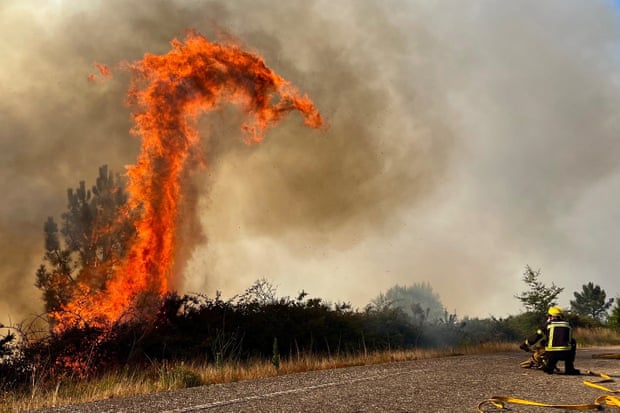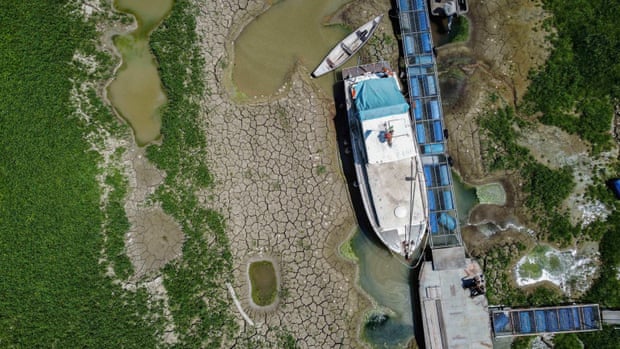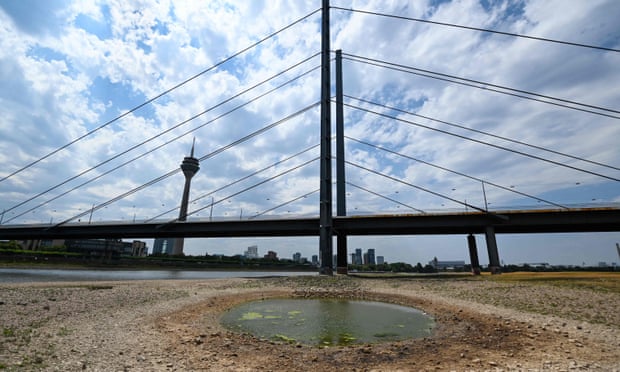EExperts warn Europe's worst drought in decades will spread across the continent. Homes, factories, farmers and freight are being hit Dry winters and scorching summers mean that global warming will make water scarcity the 'new normal'.
The EU European Drought Observatory found that 45% of the bloc's territory had received drought warnings by mid-July, and 13% had already issued emergency alerts.The European Commission has warned of "critical" conditions in several regions
since repeated heat waves across the continent. , the situation is getting worse. In France, her Prime Minister Elisabeth Borne last week set up a crisis management unit to deal with what has been described as the worst drought in the country since records began in 1958. rice field.
In his more than 100 municipalities in France, Environment Minister Christophe Bechu said drinking water is running and being supplied by truck, adding: Adaptation is no longer an option, it is an obligation.
With the lowest topsoil humidity on record and 85% less precipitation in July than normal, 93 of the country's 96 mainland prefectures have imposed hosepipe and irrigation bans. 62 provinces have been classified as 'at risk'.
GraphicsFrance's Agriculture Minister warns that maize yields will fall as food prices rise following Russia's invasion of Ukraine. Farmers' unions, which have warned that 18% or more are likely, say cattle feed shortages as a result of drought could lead to significant shortages of milk in the fall and winter.
Electricity company EDF last week was forced to cut power output from one of his reactors in southwestern France due to hot water in the Garonne River, leaving reactors along the Rhone River issued several similar warnings.
Spainwater reserves are at an all-time low of 40% and are declining at a rate of 1.5% per week due to a combination of increased consumption and evaporation. It could be the driest conditions in the last 60 years.
The country has received less than half of the expected annual precipitation over the past three months. Restrictions are in place from Catalonia in the northeast to Galicia in the northwest and even west Extremadura. Andalusia in the south.

Most water restrictions are imposed on domestic users, with rural authorities are often reluctant to curb farmers' frequent and illegal exploitation of increasingly scarce resources. - One tenth of Spain's water consumption.
A post-pandemic resurgence in tourism has seen consumption rise by as much as 10% in cities such as Barcelona, with restrictions likely to apply if rainfall is not immediate or forecast. High will be charged next month.
"Climate change studies warn droughts will become more intense, more frequent and longer," said Nuria Hernández-Mora, co-founder of New Water Culture. Stated. "While this will be the new normal, we continue to acknowledge that it will increase the use of resources that we do not have and that are increasingly scarce."
This year alsoIt will be the hottest and driest year ever recorded in Italy "I don't know what more needs to be done to trigger the climate crisis." No, it's a political theme," said Luca Mercari, president of the Italian Meteorological Association.
"There is no similar data for the last 230 years to match the drought and heat we are experiencing this year. Then came the storms...these episodes were the most consistent with climate reports over the past 30 years. Exactly as predicted, it's increasing in frequency and intensity.Why keep waiting to prioritize this?"
One of the most prominent signs of crisis is the dried up River Po.The flow ofItaly's longest waterway has fallen to one-tenth of normal, but its water level is two meters below normal. The government declared a drought emergency in her five regions in the north in early July and distributed drinking water. The villages around Lake Maggiore are served by trucks.
Since November, no rain has fallen in the region, threatening risotto rice production in the Po Valley, which accounts for about 40% of Italy's agricultural production. Farmers warn that paddy fields are becoming dry and salty, and record low water levels are pushing more seawater into deltas, potentially causing up to 60% of their crops to be lost.

The crisis is not limited to southern Europe. Also the level of the Rhine, an important northwestern European waterway used to transport oil, gasoline, coal and other raw materials, connecting the industrial center of Germanywith the main port of Rotterdam lowered to dangerous levels. and Antwerp.
River levels on Monday are already lower than they were at the same point in 2018, when a severe drought eventually stopped him from delivering goods for 132 days. Some vessels are operating at 25% capacity to avoid groundings, driving up cargo costs.
Chancellor Olaf Scholz serviced power plants reopened in the face of Russia curbing natural gas supplies just as a drought hit Germany's waterways.

In the capital city of Berlin, authorities have documented a drop in water levels in many lakes fed by the River Spree. In the southern city of Nuremberg, dry city trees are watered from closed municipal indoor pools to save gas.
In Switzerlandthe dairy industry was hit hardest. The authorities of Friborg, Jura and Neuchâtel usually required him to open the pastures in the valleys, which were not used for grazing until September. It was already too dry.
Dominique de Boumin, chairman of the Fribourg cheese-making cooperative, told Le Temps newspaper that cheese and milk production would likely be hit. , we may even run out of Gruyère eventually,” he said.
In the canton of Obwalden, near Lucerne, the army was called in and had to carry water by helicopter from Lake Sarnen to the thirsty cows in the village of Kölns.
The Netherlands declared an official water shortage last week. The government has yet to introduce limits on household consumption, but it is asking people to think carefully about whether they need to wash their cars or fill their pools completely.
Meanwhile, in nearby Belgium, forecasters reported the driest July since 1885. Despite farmers being banned from pumping water for their crops, Flanders has very low groundwater tables, drying out peatlands and a concern for wildlife, including sandpipers.
Canals and rivers are also in bad shape. Local authorities report that many fish have died because the only water left in some waterways is industrial wastewater or sewage. Thirteen communes in the Ardennes forbid people to fill pools with water.
Scientists say that unless governments around the world radically cut carbon emissions, climate collapse could soon lead to frequent and frequent summer droughts in Western Europe. says extreme heat waves that used to occur once every ten years could occur every two to three years.
Reported by Stephen Burgen of Barcelona, Angela Giuffrida of Rome, Philip Oltermann of Berlin, Jennifer Rankin of Brussels


